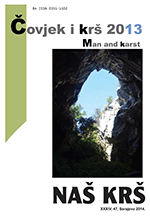UTJECAJ VJEŠTAČKOG ODVODNJAVANJA NA REŽIM PODZEMNIH VODA U TRESETIŠTU ŽDRALOVAC
THE IMPACT OF ARTIFICIAL DRAINAGE TO THE GROUNDWATER REGIME IN THE ŽDRALOVAC PEATLAND
Author(s): Nijaz Zerem, Ćerić AdmirSubject(s): Geography, Regional studies, Physical Geopgraphy, Environmental Geography, Applied Geography
Published by: Centar za krš i speleologiju
Keywords: peatland; wetland; groundwater regime; Livanjsko polje;
Summary/Abstract: Livanjsko polje is the largest karst field in Bosnia and Herzegovina; and one of the largest in the world. As of 2008 the field is inscribed in the Ramsar List of Wetlands of International Importance. Three wetlands existed in this location in the recent history. Due to human interventions aimed at utilization of land and water resources; two wetlands have been destroyed beyond the point of restoration.The third wetland and peatland; Ždralovac; which is located in the northwestern corner of the field; although damaged; is the only one in the existence today. The devastation is partly due to the construction of melioration channels in its southeastern part; where the peat layer is thin; so the peatland has been converted into agricultural land. There are damages of the peatland in the area built of peat layers more than 2 meters thick; caused by the construction and operation of drainage channels built to facilitate the peat extraction. These interventions have resulted in significant alterations of the peatland morphology and hydrological regime. The loss of moisture in peat often triggers fire; especially during prolonged dry periods; causing significant devastation of the wetland’s biodiversity.The paper presents the results of the research carried out to analyze the impacts on the Ždralovac peatland and wetland caused by the alterations in the hydrological regime. The results of a recent research; carried out in the period from 2011 to 2013; were compared with the historical data; collected in 1960’s and before. The results indicate that a large part of the peatland gets completely drained during dry periods of year; which suggests that the restoration of the groundwater regime has to be achieved in order to avoid further degradation of the peatland and the loss of biodiversity.
Journal: Naš krš
- Issue Year: XXXIV/2014
- Issue No: 47
- Page Range: 24-35
- Page Count: 12
- Language: Bosnian, Croatian, Serbian

